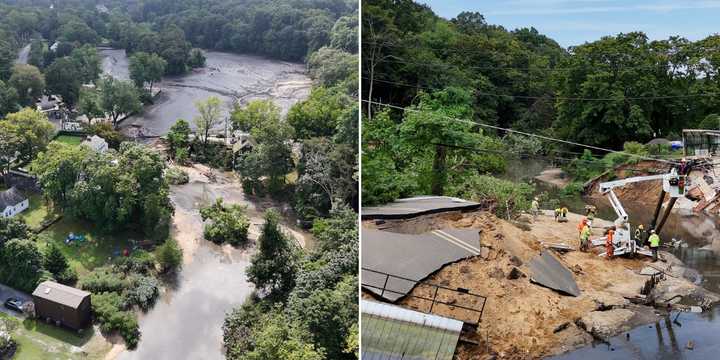Gov. Kathy Hochul declared a disaster emergency for Suffolk County on Friday, Aug. 23, following this week’s record rainfall that resulted in major flooding to homes and businesses, and washed out several roads.
Hochul’s office also announced that impacted homeowners may be eligible for grants of up to $50,000 to fund or reimburse certain qualifying health and safety related repairs not covered by insurance or other relief programs.
The program, which is being administered by New York Homes and Community Renewal, requires that applicants be homeowners who occupy the home as a primary residence and have a total household income that does not exceed 150 percent of the area median income.
Homeowners who wish to be notified when applications open are asked to complete this form.
Hochul will also submit a request for a federal emergency declaration from President Biden to support response and recovery operations, her office said.
Such a declaration would authorize the Federal Emergency Management Agency (FEMA) to provide reimbursement for debris removal operations and any work done to prevent further damage to critical infrastructure like roads, bridges, and utilities.
“We are working around the clock to ensure that impacted residents and municipalities are able to rebuild after this devastating flooding event," Hochul said.
“Protecting New Yorkers is my top priority, and I am committed to supporting Long Island throughout the recovery process.”
Widespread Damage
Widespread flash flooding ravaged parts of Suffolk County starting Sunday, Aug. 18, after up to nine inches of rain fell in parts of the area from a powerful storm system.
The storm – which prompted the National Weather Service’s first-ever flash flood emergency for Suffolk County – prompted multiple swiftwater rescues, especially in the Town of Brookhaven.
Rescues were reported in Ronkonkoma, Smithtown, St. James, and Nesconset.
Flooding washed out or closed several roads and led to the complete failure of the Mill Pond Dam, leaving six families displaced.
Over 2,000 residents and businesses suffered flood-related damage, Hochul’s office said. Among the impacted was Stony Brook University, where hundreds of students were relocated or sheltered due to infrastructure damage across the campus.
Damage assessments found more than 70 structures that had major damage or were destroyed, the governor’s office said.
In Connecticut, two women died after being swept away by flood water in separate incidents in New Haven County on Route 67 in Oxford.
Dealing With Insurers
Hochul’s office provided the following tips for homeowners dealing with insurers:
File Claims Promptly – Homeowners who experienced property losses are urged to file insurance claims with their insurers promptly and as soon as possible after losses occur. It is important to provide policy numbers if possible and all information relevant to the loss. To best document losses, homeowners should take photos or videos showing the extent of the losses before cleaning up damage.
Making Necessary Repairs – Homeowners should protect their property from further damage after a loss but should make only repairs necessary to prevent further damage to property, like covering broken windows. Permanent repairs should not be made until after insurers have inspected losses.
Keep Records of Dealings with Insurance Representatives – Homeowners should cooperate fully with their insurers and keep a diary of all conversations with insurance representatives, including the representatives' names, as well as the times and dates of all calls or visits. They should also follow up in writing with representatives to document their understanding of any conversations they have had with the representatives.
Inventory of Your Belongings – Provide your insurer with a detailed room-by-room inventory of damaged personal items and property. Include receipts, such as credit card statements or other documents showing the items' values.
Flood Damage – Homeowners are reminded that flood damage is generally only covered by flood insurance, which is a federal program administered by the Federal Emergency Management Agency (FEMA). Homeowners who have flood insurance and have flood damage should make claims through that insurance. Additionally, homeowners should also read their policies carefully to make sure they understand what damage is covered and under what circumstances.
Keep Your Receipts If You Relocate During Repairs – If you need to temporarily relocate while your home is being repaired, make sure to keep receipts and other records of your expenses during that time.
Filing Complaints – Homeowners unable to resolve disputes with their insurers may contact DFS to file a complaint at the following website location. DFS investigates all complaints it receives.
Information on Homeowners' Insurance – Additional information can be found at the Homeowners Resource Center on the Department of Financial Services' website.
Click here to follow Daily Voice Shoreham-Wading River and receive free news updates.
